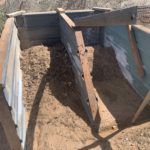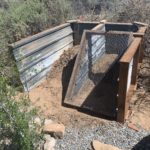Millions of households in the United States (I assume other “advanced” countries as well) throw organic materials that they generate in their kitchens into the trash bin. This is another example of our departure from things related to the earth and growing food – a waste whose massive impact to our environment is largely absent from the minds of people currently. Recycling programs have sprouted up in some communities but they cannot keep up with the volume of waste or find markets for many of the recycled materials. Organic food waste represents a substantial portion of household waste. While it’s hard to find information on what percentage of this waste gets composted by waste handlers, the (EPA says that around 35% of what we throw away gets recycled or composted and that around 27 million tons of yard and food waste gets composted every year.
https://archive.epa.gov/epawaste/nonhaz/municipal/web/html/
But that includes all types of waste not just organics. My question is why don’t more people compost locally?
As a kid, I watched my father compost grass clippings, leaves and even newspapers and incorporate them into his vegetable garden. He consistently had very successful and high producing gardens and always attributed his success, in part, to aggressive composting. Since then, I’ve composted practically all of my kitchen waste and produced an impressive amount of compost that was used to make the landscape more fertile. Even during brief stints of apartment living, I made an effort to save coffee grounds and incorporate them into the grounds around the apartments. At the farm in Mississippi, I’ve generated many truckloads of composted garden soil over the years.
After our latest move to Albuquerque, I started an impromptu compost pile out behind the back wall. Moisture is required to compost and this is a challenge in the dry New Mexico climate. In any case, the pile has produced a good bit of gardening/potting soil after being in place for 2 years.
Everything organic goes in to our kitchen pail along with a good bit of water from rinsing pots and pans before final washing. The pail fills about every 2 or 3 days and is emptied into the outdoor pile. Our pail, shown here, is available on-line and features charcoal filters to minimize any odor. But, any plastic bucket with a lid would do. The outdoor pile had grown quite a bit over those 2 years and required some reorganization and beautification if my wife was going to allow the process to continue. After months of promises, I finally got around to building my dream composting station.
Using salvaged roofing material from a neighbors roof replacement and lumber cut on the portable sawmill, I built panels for the sides and center divider. All exposed wood was treated with outdoor preservative to help extend the life of the station. Overall dimensions are 7 ft. length, 6 ft. width and 3 ft. depth. All new waste is deposited at the left compartment. Here, I can turn the compost at intervals to help speed up the process with plenty of room to segregate materials that are at different stages of decomposition. When part of the compost is ready, I can drop the screen at right and process the compost into 1/2″ minus sized material. Anything that drops in front of the screen gets placed back into the composting side of the station. I’ll add a bench at right to sit on when potting plants eventually. I’ll also place a perforated pipe(s) under the compost on the left side to aid in oxygenating the pile to further speed up decomposition. I may need to add a cover to help reduce over-drying during the arid New Mexico summer months.

Screen up to move processed material back for storage – kitchen waste composting at left and processes material at right
I would encourage anyone to try to find some way to compost. If you are fortunate enough to have a community recycling program for kitchen waste, great. If not, look into small recycling bins available at garden centers or on-line. Put coffee grounds around potted plants or in a landscaped or wooded area outside. Or, build a gigantic composting station like I did. Do something! I will even accept kitchen waste from anyone willing to collect it and bring it by the new station. The organics we are wasting represent a huge value as fertilizer and soil conditioning for the the plants around us that we love so much. Let’s compost instead of building more and larger landfills to dump organics that will inevitably contaminate groundwater, generate “climate warming” methane, and contribute nothing to the nurturing of the flora around us. Let’s look at kitchen waste from a different point of view. Happy composting!
PS. In early March of 2021, I harvested a couple of cubic yards of beautiful compost, screened through the compartment at right. This screen leaves all the big, uncomposted items on the ground for recycling back into the box at left and produces just the right blend of composted plant food under the screen at right. Truly joyful! I added a piece of sheet metal on the left side to keep our dog (and other critters) from getting into the compost pile.




